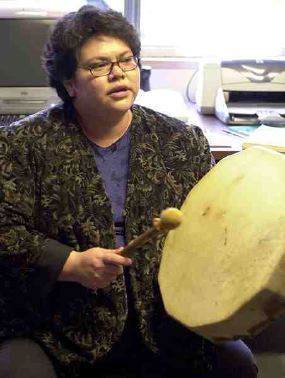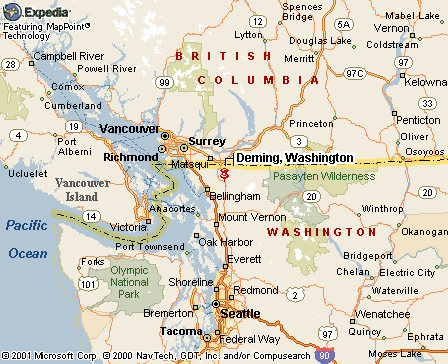|
|
Canku Ota |
|
|
(Many Paths) |
||
|
An Online Newsletter Celebrating Native America |
||
|
February 23, 2002 - Issue 55 |
||
|
|
||
|
Nooksack Program Revives a Nearly Extinct Language |
||
|
by Kari Thorene Shaw, The
Bellingham Herald
|
||
|
credits: Rachel
E. Bayne, Herald Photo
Language Specialist: Catalina Reneria, a Nooksack language specialist, sings a song for the language program. |
 DEMING,
WA - Quentin Charlie admits his mouth didn't take quickly to forming the
complex, singsong words of his grandmother's language. DEMING,
WA - Quentin Charlie admits his mouth didn't take quickly to forming the
complex, singsong words of his grandmother's language.
"I was afraid I was saying it wrong and it would make her mad," he said. But he kept going to the Nooksack Tribe's Upriver Halq'emeylem language classes. And though the language was nearly extinct 30 years ago, he now can say greetings and recite the alphabet. Nooksack language specialist Catalina Renteria expects Charlie and his classmates will be fluent by next fall. They will be her program's first graduating class and the first native language students in the United States to learn with an interactive computer program she adapted to Halq'emeylem (say "Ha-kuh-may- lem"). "It's been really fun, with the new computer age, but it's been scary because no one has ever done it," Renteria said. "You have to go out and take steps in the dark." Roland Holterman, director of the Nooksack Education Department, called Renteria's one-year project a breakthrough. He envisions local school districts offering the classes for foreign language credits soon. "We've taken a nearly extinct language and brought it back to life," Holterman said. "You can actually not speak a single word ... and in the matter of a year you can be totally fluent." Lost language Stormy weather had kept the Nooksacks from signing the Treaty of Point Elliott in January, 1855; because of that, the tribe was left without land and ordered to move to the Lummi Reservation. They chose not to move west. In those days, the Lummi and Nooksack people had little in common, save their roots in what is now Whatcom County. Their languages were about as similar as German and English, Galloway said - enough to share a few words, but certainly not enough to carry on a basic conversation. Instead, a few tribal members settled in three east Whatcom County villages, but many Nooksacks moved north to be with Halq'emeylem-speaking people of the Stolo Nation near Chilliwack, B.C. Some already were related through generations of marriage. "They kept speaking Halq-emeylem and the Nooksack language was spoken less and less," Galloway said. As the generations mingled, the language withered away. The last fluent speaker, Sindick Jimmy, died in 1977. By this time, Galloway had been studying and recording the Stolo Nation's Halq'emeylem for seven years - a project that grew out of his doctoral dissertation at the University of California at Berkeley. His colleagues were trying to preserve California's indigenous languages, so he looked north to less-explored terrain. "I decided to work on the ones that were the most endangered," said Galloway, now a professor at Saskatchewan Indian Federated College in Regina. Challenge to teach With a little urging from Holterman, she picked up a 16-inch diameter q'ewet, or hand-held drum, and started tapping it gently with a fuzzy padded drumstick. Marcus Goodson, Nooksack language intern, jumped up and trained his video camera on her - more footage for the program. Renteria softly drummed, singing Halq'emeylem words and an English translation. "This was a Stolo love song," Renteria explained, tears streaming down her cheeks. "It could be about your own life or about how the trees are and how we used to have a lot of places to pick berries, but we don't anymore." Galloway said the Nooksack elders he met made a conscious choice to abandon Lhechelesem - the tribe's original language - for Halq'emeylem. "Since the language died that long ago, the elders that were left were speakers of Halq'emeylem," Galloway said. "So there was more hope they could bring it back." Halq'emeylem is one of 23 distinct Salish languages that span tribes from the Pacific Coast to Montana and as far south as Tillamook, Ore. That doesn't mean they are similar. Galloway said only a few dialects, like Lummi and Samish, are similar enough for speakers to converse. Upriver Halq'emeylem, which is the spoken language at Nooksack, is the only Salish language that is a tone language, Galloway said. Every vowel in Halq'emeylem has three different tones that, when changed, shift the meaning of the word. For instance, the word for mosquito is qwa:l, with an acute accent that makes the "a" a high pitched, falling sound. But lower the pronunciation and make the 'a' a rising sound and it means "to talk." "That's what makes Halq'emeylem challenging to teach," Galloway said. The language also embodies a different way of looking at nature and the world, Holterman said. "Generic words for 'bird' or 'salmon' didn't exist," Holterman said. "They called steelhead 'fish snakes.' The fishers would throw them back and say they weren't edible." Instead, Halq'emeylem and Lhechelesem had specific, descriptive words for different kinds of fish, rushing and charging or still rivers, and countless words for types of rain and snow. "It had to be specific because nature was central to their survival," Holterman said. High-tech solution Renteria teaches class here, but the real future of the language program is next door, inside the department's twin blueberry iMacs. "Students come in and use these computers," said Goodson. "We're restrained by funding to have a big lab." For the last year, Renteria and Goodson have videotaped discussions in Halq'emeylem, written sentences and tests, and entered them into the Le Taupe computer language program. It is the first effort ever to adapt Le Taupe to an aboriginal language. Robert Balas, a former French professor at Western Washington University, developed the program for French students. In a month, the Nooksack Tribe will have a working, interactive language center. Goodson demonstrates, opening a window on the iMac and the Halq'emeylem alphabet comes on screen. Another window opens with a video of a man in a pink shirt. As the video plays, the man mouths the pops and guttural clicks central to coastal languages. Goodson speaks into a microphone and the program plays back a recording of his pronunciation back-to-back with the man in the video. "It hits more senses," Goodson said. "You see it, you hear it, you say it." Then Goodson displays a taped dialogue between an old Indian woman and Renteria. "Speak Indian!" The older woman says, laughing. Alongside the video, the iMac displays the running dialogue in Halq'emeylem. Galloway applauded the program. "It was developed for French so it has all the accents," he said. "It was a lucky coincidence." Passing it on Renteria herself learned it as a second language. "We're going back almost a century and dealing with people in their 90s and late 80s to save the language for their great-grandchildren," Holterman said. "They are getting sickly and there aren't many left," Renteria added. It's a problem for tribes around the country that are trying to recover native languages, after nearly a century of efforts by American boarding schools to destroy them. Non-Indian educators found that barring Indian languages in schools - and requiring Indian children to attend - was an effective way to render a language obsolete. But Renteria and Goodson have one thing working in their favor that many other tribes don't: Galloway. It is his face that pops up in Renteria and Goodson's fledgling computer tutorials, enunciating the Halqamalem alphabet in streaming video. The two filmed Galloway enunciating words and letters in a 10-day marathon over the summer. "I think it's terrific," Galloway said of Renteria's work. "I would ask the elders in the 1970s, when I was working on the writing system, how technical should we be? And they said write in all the tones because we may not be able to understand it now, but our grandchildren will go to college and they will understand it. "Sure enough, all the children use computers now," he said. Saved on tape Though they already offer credit classes in the language through Northwest Indian College as Native Studies courses, Renteria and Goodson want to see the program develop further. Those college classes can serve as teacher training and certification for instructors who, in the future, could teach Halq'emeylem as foreign language classes in the Mount Baker School District. "It's a little bit of a rift that it's considered a foreign language," Holterman said. "For these kids, it's a native language." And because Nooksack children now speak English as a first language, recordings and technology help preserve the words. "It was an oral tradition, but with the new world we are in, they have to be able to read it," Renteria said. She and Goodson are burning compact discs with Halq'emeylem sentences and conversations on them, in the hope that future generations can look to them to learn - just as she looks to Galloway's recordings and books. "The only way we can learn how to speak is because he recorded all of this," Renteria said.
|
|
|
||
|
|
||
| Canku Ota is a free Newsletter celebrating Native America, its traditions and accomplishments . We do not provide subscriber or visitor names to anyone. Some articles presented in Canku Ota may contain copyright material. We have received appropriate permissions for republishing any articles. Material appearing here is distributed without profit or monetary gain to those who have expressed an interest. This is in accordance with Title 17 U.S.C. section 107. | ||
|
Canku Ota is a copyright © 2000, 2001, 2002 of Vicki Lockard and Paul Barry. |
||
|
|
|
|
|
The "Canku Ota - A Newsletter Celebrating Native America" web site and its design is the |
||
|
Copyright © 1999, 2000, 2001, 2002 of Paul C. Barry. |
||
|
All Rights Reserved. |
||

